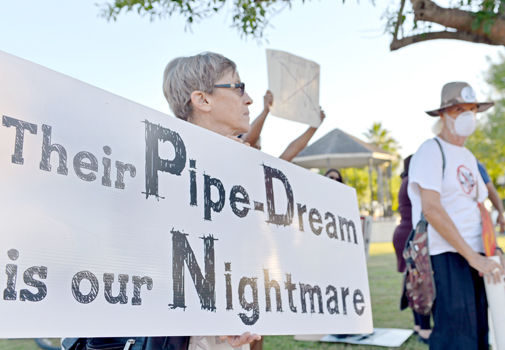BROWNSVILLE — Last night, more than 35 residents of the Rio Grande Valley, representing community organizations against liquefied natural gas, rallied in Brownsville to protest the building of LNG facilities in the area.
Placards stating “Save RGV from LNG,” “Their pipe-dream is our nightmare,” and “Fresh air not flares,” were on display.
Following the demonstration, more than 100 people attended a public meeting at the historic Brownsville Museum where the Texas Commission on Environmental Quality was to discuss whether it should grant Texas LNG air permit applications — a necessary permit prefacing construction.
After a few chants, the protestors gathered on the northwest side of the park and delivered prepared statements from featured speakers.
Convening the remarks was Joseph Cantu, a former Cameron County commissioner candidate and former employee of the refinery business, who charges that “the Texas Commission on Environmental Quality has acted as an air pollution rubber stamp, having denied 11 air quality permits since the 1970s.”
Dr. Dolly Sevier is a member of the Rio Grande Valley Coalition for Healthy Children — which has written three reports outlining different health impacts from each LNG facility with Federal Regulatory Energy Commission.
She said that “the question is not whether … the LNG facilities will be polluting our air because we know that they will; it’s in their reports,” but that the main question is “what does this pollution do to us?”
Worsening heart diseases, birth defects, learning disabilities and behavior problems were among the dangers she cited as threatening to the community.
She concluded by saying that climate change is “a very real thing” and that “pretending like it doesn’t exist and continuing on this pathway in using fossil fuels is not going to get us into the next century; it may not even get us into the next 50 years,” she said.
Josette Cruz is a mother of two and Brownsville native. Her concerns dealt with protecting the health of the community from a parent’s point of view. As a mother of a special needs child, she said that “I can’t be sold, my children’s health cannot be sold, either, and I’m sure a lot of parents feel the same way.”
Cruz held a placard suggesting that U.S. Rep. Filemon Vela sold out children.
When asked how Vela had sold out the children in his district, she alluded to donors of his such as Exxon Mobile and Astrazeneca, a pharmaceutical company.
Perez admitted Exxon is not an LNG company but nonetheless was in the oil and gas industry and that Vela’s inaction demonstrated a betrayal that could have been better served by him saying to LNG “take your jobs and shove it …”
Last on the sheet was Dr. Neil Carman, Clean Air director of the Sierra Club’s Lone Star Chapter. He worked for the Environmental Protection Agency for 12 years, inspecting chemical plants and refineries, all of which he said had accidents on an all-too-regular regular basis.
His primary concern centered on there being “no buffer zone proposed for these LNG facilities.” He says there should be a buffer zone of three miles to protect public safety. The TCEQ, he said, does not regulate this but registered the concern nonetheless.
After Carmen’s statements, the protestors headed over to the public meeting at the Historic Brownsville Museum, where residents with an opposing viewpoint held placards of their own.
“Join me in supporting this safe and responsible industry that will pump billions of dollars into our economy,” read an opposing placard.
Veterans who support LNG natural gas, such as Tony Garcia, a Vietnam War veteran and Brownsville resident, attended the public to support the jobs LNG would create for veterans who struggle finding employment.
The concerns expressed by protestors at the rally were expressed to the board, the recording of which will be published by the TCEQ shortly, according to the commission.





